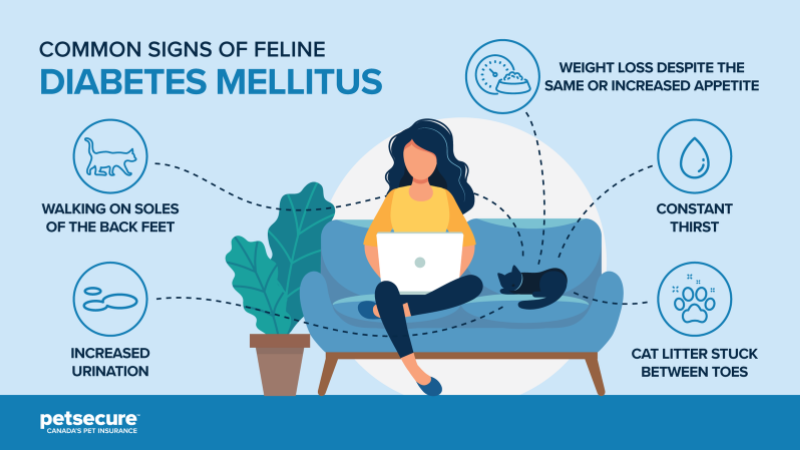
“No way!” is the most common response I hear when telling someone their cat has diabetes. Pet owners are often surprised to learn their cat will need an injection twice a day to manage kitty diabetes. Managing diabetes mellitus in cats is daunting, and often owners can be overwhelmed when they find out long term treatment may be necessary.
Diabetes mellitus in cats has a lot of similarities to diabetes in people. It’s a condition where the pancreas secretes the hormone insulin to help regulate blood sugar (also called glucose).
The body’s cells don’t respond to the insulin, and glucose can’t move from the bloodstream into the cells. The lack of glucose results in the body going into starvation mode across many organs. The excess glucose is filtered through the kidneys and into the urine.
Risk factors that contribute to cats developing diabetes are also similar to humans. An obese cat is four times more likely to develop diabetes in their lifetime. Other factors that may contribute are age, physical activity, and breed.
Less than 1% cats will receive a diabetes diagnosis in their lifetime. However, knowing signs and symptoms of feline diabetes mellitus could help save your cat’s life!
Common signs and symptoms of diabetes in cats
- Increased thirst
- Weight loss despite the same or increased appetite
- Increased urination
- Kitty litter stuck between the toes
- Walking on the hocks (plantigrade stance)

Treatment: How to monitor your cat’s blood sugar
If your cat has been diagnosed with diabetes mellitus, daily monitoring of insulin levels is very important. The following four tips will help you provide your cat with the best possible care:
1. Insulin injections are the best way to keep blood sugar levels stable.
Your veterinarian will tell you which insulin is best for your cat. Most cats will need injections twice a day to maintain consistent blood levels. Ensure all family member who give insulin know how to measure the dose accurately and are not changing the dose without speaking to your vet first. Don’t be worried about the needles; they’re tiny and the dose you’re giving is small.2. Regular blood sugar monitoring is critical.
There are a few ways to check your cat’s blood sugar levels. Your veterinarian may recommend in-hospital testing called a blood sugar curve, especially when a cat is first diagnosed with diabetes.Many pet owners learn how to collect blood sugar readings at home by pricking their cat’s ear or paw pad with a small needle. This testing tends to be more accurate, because cats are less stressed in their own space.
Technological advances for human diabetics have given us small skin implants that can measure glucose for up to 14 days with a special reader or smartphone app. This is a great option for pets who tolerate the little monitors over their shoulders/backs.
Additional diagnostic testing for fructosamine levels, kidney and liver function, and urine checks are routine in the management of diabetes in cats.
3. Diet changes.
Obesity is a common risk factor for the development of feline diabetes. Your doctor may recommend a low carbohydrate diet, most often in a canned formula to promote well-controlled blood sugar levels. Overweight cats will be given specific plans to ensure healthy weight loss.4. Don’t wait for treatment.
Complications of untreated or poorly controlled diabetes include nerve damage to the legs, kidney failure, cataracts, and a condition called diabetic ketoacidosis which is fatal if not treated in time. On the other hand, early and intensive treatment of diabetes in cats can result in a state of remission where cats don’t need insulin injections to keep blood glucose levels under control. Even cats who need insulin can live for years with regular veterinary care.Can a diabetic cat’s blood sugar go too low?
One of the most important things I tell my clients after they start insulin therapy is to never give a cat an insulin dose if they have stopped eating, started vomiting, or seem wobbly. These behaviours may be the result of hypoglycemia and should be taken seriously. Hypoglycemia occurs when the blood sugar levels become too low and can result in seizures, coma, and even death.
Some cats will only show subtle signs like irritability or shivering. If you are concerned, offer your cat some canned food to see if they will eat. If they collapse or can’t swallow this is a true emergency, and hypoglycemic cats need to be transported to the veterinary clinic for immediate treatment.
It is possible for a diabetic cat to go into remissions, but if you’re reading this and you cat doesn’t have any of the symptoms, think about taking preventative action!
- Make sure your cat is a healthy weight!
- Feed your cat the right food
- Take your cat to the vet for yearly checkups
- Ensure your cat stays active!
